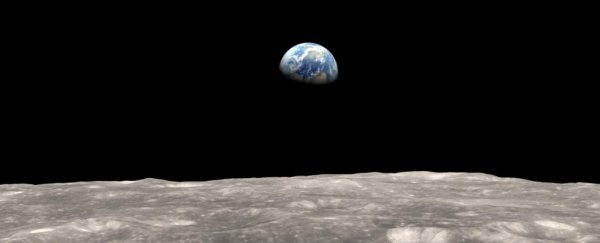Earth's oldest known rock may have been found, in the last place anyone would have thought to look for it: in samples of rock from the Moon, brought back home to Earth by Apollo 14 astronauts in 1971.
We're not talking about a "Moon was once part of Earth" rock (that's just one hypothesis for the Moon's origin, anyway).
Nope. According to an international team of scientists, there's evidence the rock was terrestrial in origin - it's a 2-gram piece of quartz, feldspar, and zircon embedded in a larger chunk of rock called Big Bertha - minerals that are rare on the Moon, but really common here on Earth.
And chemical analysis has revealed that it formed in an oxidised system like Earth's, in Earth-like temperatures, rather than the Moon's temperature conditions. If it had formed on the Moon, that would require conditions never before inferred from lunar samples.
So how the heck did it get there, then?
According to the scientists, it was launched off Earth about 4 billion years ago when an asteroid or comet slammed into our young, roughly 540-million-year-old planet, sending rock fragments flying off into space.
Because the Moon was much closer to Earth at that point - about three times closer than it is now - it was in a better position for pieces of this debris to end up there.
 (LPI/David A. Kring)
(LPI/David A. Kring)
"It is an extraordinary find that helps paint a better picture of early Earth and the bombardment that modified our planet during the dawn of life," said earth and planetary scientist David Kring of the Lunar and Planetary Institute.
(Kring had challenged the team, led by Jeremy Bellucci of the Swedish Museum of Natural History and Alexander Nemchin of Curtin University in Australia, to find a piece of Earth on the Moon. Guess they won.)
The team was able to perform more detailed analyses on the rock. The inclusion of zircon was particularly useful, since zircon contains uranium, the known half-life of which allows for accurate dating.
The formation of the rock was therefore dated to about 4 to 4.1 billion years ago. It formed under the planet's surface at a depth of about 20 kilometres (12.4 miles), where it remained until a violent impact hurled it into space.
From there, it made its way to the Moon, where further impact events probably partially melted and buried it around 3.9 billion years ago.
 Big Bertha. (LPI)
Big Bertha. (LPI)
It was then returned to the surface around 26 million years ago, during the impact event that produced the Cone Crater - where it remained until Big Bertha was collected by Apollo 14 astronauts just a few decades ago.
It's possible that the fragment did indeed form on the Moon, but the conditions for that would be unlike anything we've seen on the satellite. It would've had to have formed 30 to 70 kilometres below the surface, in an "unusually oxidising magmatic environment" with oxygen levels much higher than those in the lunar mantle 4 billion years ago.
By contrast, the terrestrial conditions seem much more likely - even if it seems a spectacular coincidence that this tiny fragment was later returned to Earth.
But it might not be so hard to verify. If one fragment could be found, there should be others, and studies of other lunar samples may locate them. In addition, with NASA's plan to return humans to the Moon, there could be future opportunities to collect even more samples.
The team's research has been published in Earth and Planetary Science Letters.
